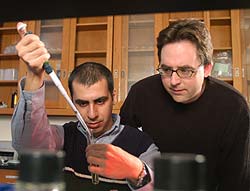Articles and reports from the Life Sciences and chemistry area deal with applied and basic research into modern biology, chemistry and human medicine.
Valuable information can be found on a range of life sciences fields including bacteriology, biochemistry, bionics, bioinformatics, biophysics, biotechnology, genetics, geobotany, human biology, marine biology, microbiology, molecular biology, cellular biology, zoology, bioinorganic chemistry, microchemistry and environmental chemistry.

Sometimes finding out what doesn’t matter in science is just as important as finding what does.
That’s the case for a study that looked at the function of the viral protein, MTase1. Researchers found that the rate of virus replication in tissue culture was not affected when MTase1 was removed.
The finding is important as researchers look for what proteins are essential and how they function in cells, potentially providing answers to everything from insect control to the co

Technique could lead to new drug delivery systems, biological warfare sensors
Using a lab technique called domain insertion, Johns Hopkins researchers have joined two proteins in a way that creates a molecular “switch.” The result, the researchers say, is a microscopic protein partnership in which one member controls the activity of the other. Similarly coupled proteins may someday be used to produce specialized molecules that deliver lethal drugs only to cancerous cells. They also m

Researchers at the University of California, San Diego have discovered how to transfer the optical properties of silicon crystal sensors to plastic, an achievement that could lead to the development of flexible, implantable devices capable of monitoring the delivery of drugs within the body, the strains on a weak joint or even the healing of a suture.
The discovery is detailed in the March 28 issue of Science by a UCSD team that pioneered the development of a number of novel optical sensor

How nature tries to compensate for the vulnerability of male babies
New research from Italy reveals that mother nature tries very hard to compensate for the fact that male foetuses and newborns are more fragile than females by allowing significantly more boys to be conceived at a time of year when conditions for pregnancy and birth are optimal.
Evidence that males are more fragile than females and that fewer males are conceived in sub-optimal conditions is not new. What is new in

Scientists from the John Innes Centre (JIC), Norwich (1) have today reported that highly toxic compounds, called free radicals, are essential to plant growth. The researchers had found that the controlled production of free radicals is an essential first step in switching on the expansion of cells that underlies the growth of plant shoots, roots, leaves and buds. A phenomenon that is especially evident in the spring. The research is reported in the international scientific journal Nature.
“T

Finding how E1 enzyme juggles three jobs should lead to critical insights into the control of cellular functions at the heart of health and disease
Scientists at St. Jude Children’s Research Hospital have discovered how a single enzyme called E1 performs a rapid-fire, three-part chemical makeover of a protein that helps control some of the most fundamental biochemical processes of the human cell. The enzyme uses two different parts of its own structure to juggle four different mo